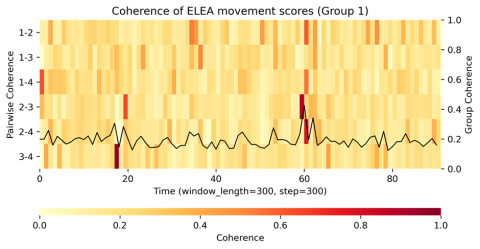Synchrony Software - CSAI Researchers Develop New Tools for Studying Coordination
Travis J. Wiltshire and his colleagues in the Cognitive Science & AI Department at Tilburg University have recently developed a software package for examining coordination. Coordination, sometimes called synchrony, happens when two or more signals, such as the heart rates of team members, align over time. Measures of synchrony allow us to look at how teams adapt to challenging situations. MultiSyncPy is an open-source software package for the Python programming language.
Teamwork is required in nearly every facet of modern work. And, it’s particularly important when unexpected events such as crises arise that teams are able to adapt to the challenge. Imagine, for example, how it would feel if you arrived at the hospital emergency room. A team of healthcare professionals is there preparing you for a life-saving surgery. But how do you know that this team can work together and coordinate effectively? They could be working together for the first time on that very surgery.
Afterall, not all teams are successful at adapting to unexpected situations. And, sometimes their ability to work together as a team can break down entirely. For example, when there is an equipment malfunction during an emergency procedure, the team must adjust to this new situation. MultiSyncPy is an open-source software package for the Python programming language. It includes several methods for examining and visualizing synchrony in multiple signals, such as the physiology of team members, and how they change over time.
By applying MultiSyncPy to data from teams specifically, Dr. Wiltshire and his colleagues can study what makes adaptive teams successful. This is part of a larger effort to develop methods for identifying when teams are coordinating effectively (i.e., effectively timing their cognition and behavior and aligning physiologically). And, alternatively, developing ways to intervene when teams exhibit breakdowns in their teamwork.
To provide an example, the Figure below shows a coordination metric called coherence. When coherence is 1 (red), coordination is very high, and when it is 0 (light yellow) there is no coordination. The data are movements of four team members working on a problem. MultiSyncPy can generate visualizations that allow for examination of the average team coherence over the duration of the interaction (the black line). It also allows for examining how pairs of team members coordinate uniquely (see rows along the left axis indicating team member 1 and 2, 1 and 3, and so on).
While Dr. Wiltshire and his colleagues mainly apply MultiSyncPy to data derived from teams, the methods and tools included in the package are generalizable to many kinds of signals. For example, it is common to look at the coordination of signals in other interpersonal contexts such as psychotherapy (e.g., whether a patient and therapist are aligned in their physiological responses) and even in ecological contexts such as how animals move around in their environment or how various climate indicators change together over time.
This work is essential so that we can ensure our teams are able to respond to whatever crises our society might face, whether they be as large-scale as solving the global climate crisis or as personal as healthcare teams saving individual lives in the emergency room.

